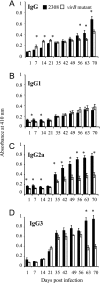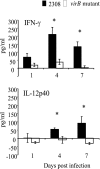Inactivation of the type IV secretion system reduces the Th1 polarization of the immune response to Brucella abortus infection
- PMID: 18458071
- PMCID: PMC2446720
- DOI: 10.1128/IAI.00203-08
Inactivation of the type IV secretion system reduces the Th1 polarization of the immune response to Brucella abortus infection
Abstract
The Brucella abortus type IV secretion system (T4SS), encoded by the virB operon, is essential for establishing persistent infection in the murine reticuloendothelial system. To gain insight into the in vivo interactions mediated by the T4SS, we compared host responses elicited by B. abortus with those of an isogenic mutant in the virB operon. Mice infected with the B. abortus virB mutant elicited smaller increases in serum levels of immunoglobulin G2a, gamma interferon (IFN-gamma), and interleukin-12p40 than did mice infected with wild-type B. abortus. Despite equal bacterial loads in the spleen, at 3 to 4 days postinfection, levels of IFN-gamma were higher in mice infected with wild-type B. abortus than in mice infected with the virB mutant, as shown by real-time PCR, intracellular cytokine staining, and cytokine levels. IFN-gamma-producing CD4(+) T cells were more abundant in spleens of mice infected with wild-type B. abortus than in virB mutant-infected mice. Similar numbers of IFN-gamma-secreting CD8(+) T cells were observed in the spleens of mice infected with B. abortus 2308 or a virB mutant. These results suggest that early differences in cytokine responses contribute to a stronger Th1 polarization of the immune response in mice infected with wild-type B. abortus than in mice infected with the virB mutant.
Figures






References
-
- Alton, G. G., L. M. Jones, and D. E. Pietz. 1975. Laboratory techniques in brucellosis. Monogr. Ser. World Health Organ. 1-163. - PubMed
-
- Araj, G. F. 1999. Human brucellosis: a classical infectious disease with persistent diagnostic challenges. Clin. Lab. Sci. 12207-212. - PubMed
-
- Branden, L. J., and C. I Smith. 2002. Bioplex technology: novel synthetic gene delivery system based on peptides anchored to nucleic acids. Methods Enzymol. 346106-124. - PubMed
Publication types
MeSH terms
Substances
Grants and funding
LinkOut - more resources
Full Text Sources
Research Materials

